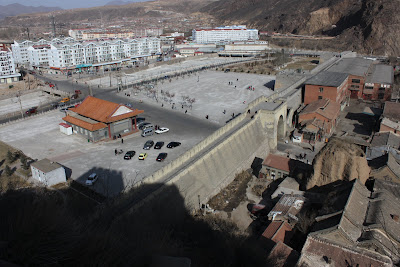
My aunt (姑姑, gugu) and uncle (姑父, gufu) have lived in Zhangjiakou, Hebei Province, for as long as I can remember, and since my grandma (nainai) is living with them right now, a trip to this small (relatively) city of 4.8 million people. (The population figure is a bit misleading; many people, especially developers, have fled south, and now there's talk of Hebei Province handing Zhangjiakou over to Inner Mongolia, for reasons not completely clear to me.)
 There are a few nice sites in this city, though, foremost being Dajingmen (literal translation: Big Border Gate; it's also the name of a TV series that aired on CCTV), which in ancient days was the gateway through Zhangjiakou City. Those who passed through were on a road (Zhangku Dadao, 张库大道, i.e. Zhangjiakou-Mongolia Expressway) that led straight to Moscow (see map, right). Lots of fur traders passed through this gate.
There are a few nice sites in this city, though, foremost being Dajingmen (literal translation: Big Border Gate; it's also the name of a TV series that aired on CCTV), which in ancient days was the gateway through Zhangjiakou City. Those who passed through were on a road (Zhangku Dadao, 张库大道, i.e. Zhangjiakou-Mongolia Expressway) that led straight to Moscow (see map, right). Lots of fur traders passed through this gate. One of the side doors, West Border Gate, was small enough that only a horsecart could pass. With mountains on all three sides and a fortified wall with tiny openings, Zhangjiakou was shielded from invaders for much of its 600-year history. Historically, it was considered a northern last stand for China's armies, since anyone who got past Zhangjiakou had a straight path towards Beiping (now Beijing, of course). More recently, Sino-Soviet forces fought back Japanese invaders from this location. (Because of its military importance, only after the 1980s could foreigners visit this place.)
One of the side doors, West Border Gate, was small enough that only a horsecart could pass. With mountains on all three sides and a fortified wall with tiny openings, Zhangjiakou was shielded from invaders for much of its 600-year history. Historically, it was considered a northern last stand for China's armies, since anyone who got past Zhangjiakou had a straight path towards Beiping (now Beijing, of course). More recently, Sino-Soviet forces fought back Japanese invaders from this location. (Because of its military importance, only after the 1980s could foreigners visit this place.)More pictures:

Gufu, nainai, gugu.

Inside a Daoist courtyard.

Looking south atop the city wall (城墙, chengqiang); remnants of Old Town fade into New Town...

View of the city wall, with condos out north (left) and flat-roof terraces to the south.


From left to right: old to new...



No comments:
Post a Comment